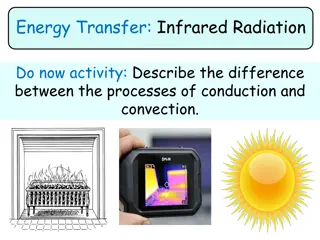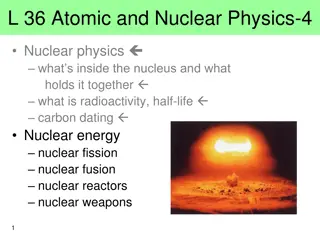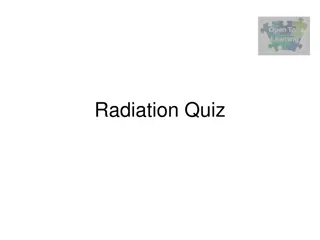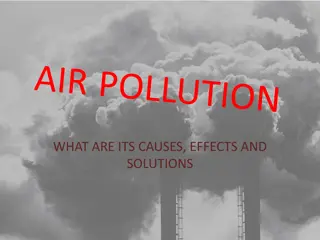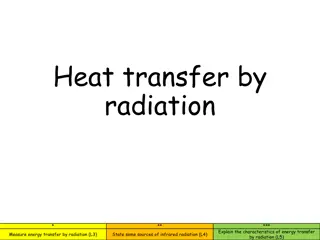Understanding Radiation Pollution and Its Sources
Radiation pollution is a serious environmental concern caused by both ionizing and non-ionizing radiation. Ionizing radiation, such as alpha and beta particles and gamma rays, can lead to cellular damage, while non-ionizing radiation, like solar radiation, can also impact living organisms. Sources of radiation include cosmic rays, terrestrial radiation from elements like thorium and uranium, as well as internal radiation stored in body tissues. Understanding these sources is crucial for managing radiation pollution and its effects on the environment and human health.
Download Presentation

Please find below an Image/Link to download the presentation.
The content on the website is provided AS IS for your information and personal use only. It may not be sold, licensed, or shared on other websites without obtaining consent from the author. Download presentation by click this link. If you encounter any issues during the download, it is possible that the publisher has removed the file from their server.
E N D
Presentation Transcript
RADIATION POLLUTION RADIATION POLLUTION
RADIATION RADIATION Radiation refers to the process that is concerned with the passage of energy between places through space. It is the radiation generated by sun that regulates the temperature of earth. CLASSIFICATION OF RADIATION: ionizing or non-ionizing types.
Ionizing radiation Non-ionizing radiation (solar radiation) Applied to radiation which has the ability to penetrate tissues and deposits its energy within them. Can cause superficial damage/injuries to living cells. The microbes can also be effectively inactivated by the use of non- ionizing radiation like ultraviolet rays. Ionizing radiation (very high energy) is represented by alpha and beta particles and gamma rays and is associated with ionization of molecules (atoms). This form is an important source of environmental pollution. Ionizing radiation (radio isotopes) is produced from materials on lithosphere. This can also be obtained directly from space.
Ionizing radiation Electromagnetic radiations This is emitted in the sunlight. This is emitted in the sunlight. Particulate or corpuscular radiations Produced by the release of the components electron (alpha & beta particles), proton and neutron of an atom from a radioactive substance. substance. Produced by the release of the components electron (alpha & beta particles), proton and neutron of an atom from a radioactive Ultraviolet, infrared, gamma and x-rays, and micro (radio) waves are well known forms of electromagnetic radiation. electromagnetic radiation. Ultraviolet, infrared, gamma and x-rays, and micro (radio) waves are well known forms of The radioactive particles can be of alpha, beta, neutron, proton and cosmic types. beta, neutron, proton and cosmic types. The radioactive particles can be of alpha, Ultraviolet rays generated by the sun cast a lasting effect on the living matter. lasting effect on the living matter. Ultraviolet rays generated by the sun cast a
SOURCES OF RADIATION SOURCES OF RADIATION Natural sources: Cosmic rays: It originates in outer space & weakened as they pass through the atmosphere.
Environmental: Terrestrial radiation: Radioactive elements present in man s environment (soil, rock & buildings) are thorium, Uranium, radium and isotopes of potassium (k40). Atmospheric radiation: Radon considered as major pollutants of the atmosphere. and thoron are
Internal radiation: Radioactive matter stored in the body tissues such as Uranium, thorium & related substances, Isotopes of potassium (K40), strontium (Sr90) and carbon (C14).
Man-made or artificial sources: X rays: Medical and dental X-ray. Radioactive fallout: Nuclear explosion release a tremendous amount of energy in the form of heat, light, ionizing radiation and many radioactive substances such as isotopes of carbon (C14), strontium (Sr90), iodine (I131) and cesium (Cs137). The half life of Sr90 and Cs137 are 28 year and 30 years respectively and also liberated in large amount. Miscellaneous: some every day appliances such as TV set and luminous wrist watches are radioactive.
RADIATION UNITS RADIATION UNITS Radiation can be expressed in various units. A curie is a unit of decay which refers to 37 billion atoms decaying per second. The impact of radioactivity is measured in what has been termed a dose. Rad (radiation absorbed dose) refers to the energy received per unit of material exposed. 100 erg/gram is equivalent to one rad. The effect of radiation on biological materials is measured in rem (Roentgen equivalent man). Radiologists frequently use the unit R (Roentgen) while conducting x-ray examination.
BIOLOGICAL EFFECTS OF RADIATION BIOLOGICAL EFFECTS OF RADIATION Divided into two separate groups Somatic effects Genetic effects Immediate: Single-dose whole body exposure of 25 rads may not lead to any observable changes however 100 rads cause vomiting and fatigue. Radioactive sickness Acute radiation syndrome A dose of 400-500 roentgens on whole body fatal in 50% cases and 600-700 in all cases. Delayed: Leukemia Carcinogenesis Foetal developmental abnormalities Shortening of life Chromosomal mutation: Associated with sterility Point mutations: affects gene
CONTROL OF RADIATION HAZARDS CONTROL OF RADIATION HAZARDS Monitoring and prevention of leakage of radioactivity from natural and man-made sources. Care should be taken while handling radioisotopes and managing the atomic power reactors. The disposal of radioactive wastes must be done under strict supervision so that no leakages occur to contaminate food, water and air. Nuclear explosion are carried in way that no scattering of radiation is allowed to occur. Radioactive sources should be shielded with the help of appropriate materials.
The personnel engaged in radiation laboratories must use film badges or criticality lockets to record exposure levels. Dose meters can also be used to monitor exposures. Necessary protective clothing can be used for preventing ill effects of radiation. Recommendation of International atomic energy agency (IAEA), International commission on radiological protection (ICRP) and WHO should be taken into consideration.




